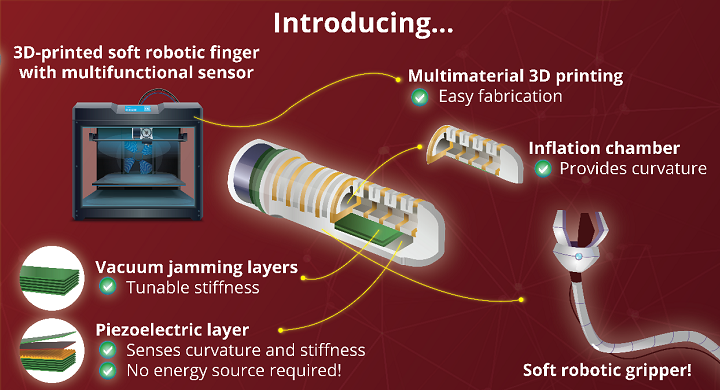Soft grippers enable robots to manipulate delicate objects, but this doesn’t necessarily mean that they’re safe to use around living organisms, such as elderly people, so researchers continue working to improve the perception of soft robotic grippers. According to a team at Ritsumeikan University in Japan, one of the main goals in robotics right now is developing a dexterous robotic gripper with capabilities that are safer and more human-like. The researchers have been working to design 3D printed soft, sensitive robotic fingers that would be a major step in the right direction toward safer robots, and recently published a study about their work in the journal Nano Energy.
The abstract states, “Proprioceptive sensation via embedded flexible sensors is essential for soft robotic grippers to realize safe and dexterous grasping. We demonstrate a self-powered, flexible multifunctional sensor by combining a polyvinylidene difluoride film with a microstructured jamming layer. The jamming layers and the finger body are fabricated by a multimaterial 3D printing technology.”
In order to complete various tasks, soft grippers should have a sense of their own position and movements, known as proprioception, but sensors are an important part of this process, and most existing sensors are too rigid to be integrated in a useful way, as they, according to a Ritsumeikan press release, “compromise the mechanical characteristics of the soft parts.” But this team, under the leadership of Associate Professor Mengying Xie, used multi-material 3D printing to make soft robotic fingers that have a built-in proprioception sensor with adjustable stiffness.
“The sensor built into the soft finger can provide passive proprioceptive sensations of curvature and stiffness, with maximum sensitivity of 0.55 mV m and 0.09 Vm/N respectively. It also acted as an active jamming element to tune finger stiffness (15–44 N/m) while not affecting the dynamics of the robotic movement. We demonstrate the multifunctional sensor with a three-fingered robotic gripper to successfully record finger bending and stiffening in the ‘pick and place’ process,” the abstract continues.
A couple of special functions make it possible for the 3D printed soft robotic gripper, which has three fingers, to grasp and hold onto objects. First, the team’s soft finger can bend in a very controllable way thanks to a reinforced inflation chamber and the air pressure it provides. A separate chamber features a vacuum, which is able to tune the stiffness of the finger through vacuum jamming: a process that sucks out the air from between multiple stacked layers of flexible material to make it rigid. Even more interesting is the piezoelectric layer that was added to the flexible materials in the vacuum jamming chamber, which acts as the sensor.
The piezoelectric effect makes a change in voltage when material is under pressure, which gave the researchers a way to use it to their advantage as a mechanism that can sense the robotic finger’s initial stiffness and curvature. A microstructured layer in the vacuum chamber further increases the sensitivity of the 3D printed soft gripper, as it improves how pressure is distributed on the piezoelectric material. The piezoelectric effect also allows the sensor to power itself, which means it doesn’t need a supply of energy.
Professor Xie said, “Self-powered built-in sensors will not only allow robots to safely interact with humans and their environment, but also eliminate the barriers to robotic applications that currently rely on powered sensors to monitor conditions.”
Multimaterial 3D printing is what made it possible for the team to easily integrate the stiffness- and sensing-tuning mechanisms into the soft gripper’s design, which will make the fingers safer to use when manipulating fragile objects, like they would in the healthcare field.
“Our work suggests a way of designing sensors that contribute not only as sensing elements for robotic applications, but also as active functional materials to provide better control of the whole system without compromising its dynamic behavior,” stated Professor Xie.
(Source: Ritsumeikan University)
